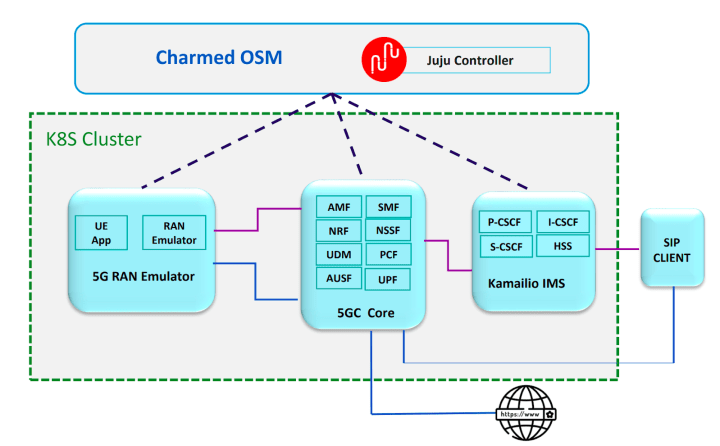Open source MANO (OSM) community recently added two more bricks in the wall of NFV orchestration events: OSM Release NINE and OSM#10 Hackfest. The community has come a long way to mature OSM into its 9th version. A toast to all the system integrators, network operators, researchers, and VNF vendors who have hit the home run there!
Canonical’s contribution towards the OSM Release NINE highlights the model-driven capabilities for network services onboarding. This model-driven approach paves the way towards the goal of multi-cloud orchestration using centralized OSM components. Another major integration is the alignment of the OSM network model with ETSI (European Telecommunication Standard Institute) SOL006 standards.
Canonical being a key member of the OSM community, also participated in Hackfest, and in collaboration with other stakeholders, covered the majority of the hackfest sessions. The event held once again behind the screens from Nov 30 to Dec 4, 2020 and focused on enhancing community interactivity and encouraging developers to participate in the project.
Canonical in OSM#10 Hackfest – The highlights
Canonical’s engagement in OSM#10 Hackfest was aiming to drive better lifecycle management of network services using a model-driven approach. The team was present both as instructors in Hackfest sessions and leaders in community technical sessions.
The Hackfest sessions were categorized into Operations, VNF onboarding, and OSM Ecosystem progression. The first three days were focused on deployment and operations of network functions over bare-metal machines, virtual machines (VMs), and Kubernetes-managed containers. The fourth day was focused on creating network descriptor packages from scratch and onboarding of virtual network functions (VNFs), physical network functions (PNFs), and Kubernetes network functions (KNFs) using operators (Juju Charms). Finally, the fifth day focused on good practices for OSM development. You can follow the event agenda on the OSM wiki for videos and presentations.
Following are some highlights presented by Canonical during the event
Model-driven Universal Operator Lifecycle Manager: Mark Shuttleworth (CEO at Canonical, and OSM technical steering committee (TSC) member) demonstrated how model-driven operators address challenges of network service lifecycle management. VNF configuration and abstraction (VCA) component in OSM provides universal operators for deployment of network services on underlying infrastructure of bare metal machines, VMs, and K8s clusters. VCA is now able to provide dynamic integration of operators in production environments which implies that service providers can add and integrate operators with the existing model. Multiple sessions on this topic were covered by David Garcia (module development lead (MDL) for N2VC (network to VNF communication)). In the end, followed by many efforts of the environment setup and preparation of Hackfest, a session on the guidelines for OSM development was covered by Mark Bariel (MDL for DevOps)
TATA Charmed 5G Deployment: Another exciting news on Charmed OSM, leveraging the management capabilities for 5G telco workloads, was announced by TATA ELXSI. The functional ability of Juju’s controller and Charmed OSM made possible the deployment of 5G Kubernetes network functions (KNFs) on MicroK8s infrastructure. All the components, i.e. Radio Access Network (RAN) and 5G Core, have been based on a model-driven operator framework that can be reused, upgraded, and integrated according to the current demands. We congratulate TATA ELXSI on this step forward!

OSM Release NINE – New ingredients
in the OSM recipe
OSM Release NINE is at the end of the tunnel to offer compelling features to telcos, system integrators, VNF vendors, and all the curious minds out there in the NFV world.
The technical plenary meetings for OSM Release NINE were held in parallel to the Hackfest sessions. The main offerings by Canonical are summarised below
Multi-Cloud scenario manager: Progressing towards “distilling your operations into code”, OSM VCA (Juju) is targeting multi-cloud support for future releases, which will allow service providers to deploy and integrate network services across various virtual infrastructure managers (VIMs). This will also enable the decomposition of even very complex network services, consisting of bare metal machines, VMs, and containers, and integrating them from a centralized unit with a consistent user experience.
Upgrades in VCA: OSM supports both proxy and native charms (operators). In native charms, operator and workload are co-located in the same machine, and in proxy charms, they reside in different machines. The addition of distributed proxy charms brings the operator near to workload on registered clouds of the same VIM. In this case, the operator can be deployed anywhere away from OSM (edge) which reduces the possibility of a single point of failure and unlocks geo-redundancy in the future roadmap of OSM.
Some other major features in the OSM Release NINE include:
- Multi-tenancy in Grafana: In previous releases, common credentials have been used for Grafana dashboards. Now, by extending the OSM’s role-based access control (RBAC) feature, the users can access the Grafana dashboards using the OSM’s credentials.
- Support of VCA deployment in Kubernetes using Charmed OSM installer.
- Support for modeling Kubernetes descriptor units using Helm version 3 and Juju bundles.
Learn more
Get started with Charmed OSM to benefit from the latest features in open source NFV management and orchestration.
To learn more about Canonical’s solutions for telcos, visit our website.
Write your first operator: follow the tutorial or the documentation.
